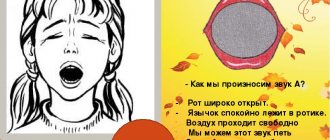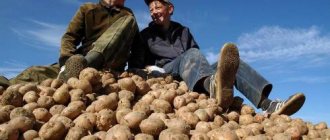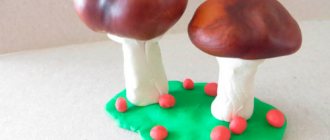MAGAZINE Preschooler.RF
Project “Trees in Autumn” in the senior group of compensatory orientation for children with mental retardationProject type: educational-research creative
Project type: group
Project duration: short-term (2 weeks)
Participants: children of the senior correctional group, a speech pathologist, a speech therapist, a teacher, a music director, and parents.
Relevance of the project:
Autumn is a favorable time of year to observe and change trees.
Children's participation in the project will allow:
- enrich knowledge and ideas about the life of trees in autumn
- give an idea that most tree leaves change color in autumn
- introduce such a wonderful autumn phenomenon as leaf fall
- remember the names of trees, their structure and purpose
- learn to take care of trees.
Expected Result:
To form in children a system of knowledge about changes in the life of trees in autumn.
Create conditions for children to develop a holistic understanding of the life of trees in autumn.
To instill in children a caring attitude towards trees.
Objective of the project:
Expanding and enriching children's knowledge about the changes that occur in the life of trees in the fall.
Project objectives:
Educational:
- expand children's knowledge about the changes that occur in nature with the arrival of autumn
- enrich knowledge about autumn natural phenomena and the life of trees in autumn
- teach to recognize and distinguish trees in the immediate environment by external signs
- Give children the opportunity to learn what determines the color of autumn leaves and how plants prepare for winter.
Correctional and developmental:
- develop visual attention and perception, memory
- develop speech and phonemic hearing
- develop observation skills and the ability to draw independent conclusions
- enrich and activate children's vocabulary
- develop lexical and grammatical skills, practice the formation of relative adjectives, coordinating them in gender, number and case
- develop coherent speech
- develop gross and fine motor skills.
Correctional and educational:
- cultivate a love for the nature of your native land
- develop independence skills
- cultivate a desire to work in a team.
Stages of work on the project
Stage I – preparatory.
Drawing up a plan for joint work with children, parents, conversations, development of OD notes, selection of artistic, demonstration, handouts and equipment for OD, didactic games with children, development of holiday leisure scenarios.
Stage II – practical. Project implementation.
Excursion around the territory of the kindergarten.
Observing trees and shrubs on walks and changes in nature in autumn.
Contents of practical activities to implement the project
for all sections of the program:
1. Cognitive development
- Getting to know the world around you:
- viewing reproductions of paintings by artists on the topic
Observation cycle:
- for changes in autumn nature during walks
- for the beauty and richness of autumn colors
- behind the trees growing on the territory of the kindergarten
- Situational conversations:
“Why do we like autumn?” , “Why can’t you break branches?” , “How to help a wounded tree?”
- Didactic games: “Which tree is the leaf from?” , “Which branch are the kids from?” , “Find out by description” , “Good - bad” , “The fourth odd” , “What is missing” .
- OOD for FCCM (teacher-defectologist) “Walk in the autumn forest”
- Formation of elementary mathematical concepts
OOD (teacher-defectologist) “Let’s help the baby squirrel learn to count”
OOD (teacher-defectologist) “How the owlet compared trees”
- Games and exercises for FEMP: “Find and show” , “Lay out correctly” , “Make it equally” , “Continue the row” , “Thicker - thinner” .
- Target walks:
“Trees and shrubs of our kindergarten”,
“Looking for signs of autumn”.
2. Speech development
- Looking at illustrations about autumn.
- Memorizing poems and riddles about trees and autumn.
- Work on retelling the text.
- Conversations: “Signs of autumn” , “Why trees shed their leaves” ,
- OOD on the formation of lexical and grammatical categories (teacher-speech therapist):
"What Happens to Trees in Autumn".
- OOD on the development of coherent speech (teacher-speech therapist): Retelling the story “Tree Argument” according to K.D. Ushinsky
- Word games: “Name it affectionately” , “One-many” , “Which sheet” , “Match the action to the object” , “Say the opposite” , “Count to five” .
- Reading fiction:
M. Prishvin “Fall of Leaves” , E. Moshkovskaya “Grandfather – Tree” ,
S. Kozlov “Such a Tree” , E. Serova “Green Country” , A. Lopatina “The Wisdom of a Tree” , A. Lopatina “The Life of a Tree” , “Lipka’s Gifts” , S. Prokofieva “The Tale of a Little Oak Tree” , E. Trutneva “Autumn” , N. Sladkov “Autumn on the threshold” , O. Belyavskaya “Leaf fall” ,
A.S. Pushkin “The sky was already breathing in autumn...” , A.S. Pushkin “Sad time!
The charm of the eyes!
3. Social and communicative development
- Role-playing games: “Seed Store” , “Family. Plot – We are going for a walk in the park .
- Didactic games: “Seasons” , “Find out by description” , “Guess the riddle - draw the answer!” , “Which branch are the kids from?” , “Find the tree by description .
- Board and printed games: “Seasons” , “Trees of our land” ,
"Collect a picture".
- Labor activity: collecting natural material while walking, cleaning up fallen leaves.
4. Artistic and aesthetic development
- Organized educational activities:
Drawing “The beauty of nature in autumn” , “Trees in autumn”
Modeling “Such different leaves” (using the “plasticineography” )
Applique “Fox from maple leaves”
Application Collective work “Birch tree in autumn”
Drawing “Our site in autumn” , “Leaf fall”
- Independent artistic activity:
- Listening to music:
P. I. Tchaikovsky “Autumn Song” , “Seasons” , A. Vivaldi “Autumn” .
5. Physical development
- Outdoor games: “One, two, three - run to the tree!” , “Autumn leaves” , “I know 5 names” (trees).
- Physical education lessons: “Leaves in autumn” , “The wind blows in our faces” ,
"Autumn leaves are quietly spinning".
- Development of fine motor skills: Finger gymnastics “Trees” , “What leaves look like” .
- Games: “Arrange the leaves by color” , “Arrange the leaves from small objects” , “Decorate the leaves” .
Stage III is the final stage.
Working with parents: exhibition of crafts “Autumn Fantasies” .
Festive leisure “Let's help the Sun return the colors of autumn”
Presentation of the project “Trees in Autumn” .
Result: The project allowed children to expand their knowledge about the nature of their native land and the benefits of trees. The children received answers to their questions and drew conclusions:
- All people need to take care of trees
- know the structure of a tree: root, trunk, branches, leaves
- love your land, your nature.
At the end of the project, the level of children's knowledge about trees increased. The project contributed to the expansion and deepening of children's ideas about the nature of their native land of the Moscow region.
Literature:
- Nikolaeva S. N. “Young ecologist” , “Mosaic-Synthesis” , 2022.
- Ushakova O.S., Strunina E.M. “Development of speech and creativity of preschool children” , “TC Sfera” , 2022.
- Maslennikov O.M., Filippenko A.A. Environmental projects in kindergarten, Volgograd: Teacher, 2016
- I.A. Pomoraeva, V.A. Pozina Formation of elementary mathematical concepts: Senior group. – M.: “Mosaic-Synthesis” , 2022.
- Koldina D.N., Modeling with children 5-6 years old, “Mosaic-Synthesis” , 2022.
- Koldina D.N., Drawing with children 5-6 years old, “Mosaic-Synthesis” , 2022.
- Bukharina K.E. Lesson notes on the development of lexical and grammatical concepts and coherent speech in children 5-6 years old with ODD and mental retardation: a methodological manual - M.: Humanitar. ed. VLADOS center, 2016.
- Bardysheva T.Yu., Monosova E.N. Speech therapy classes in kindergarten. Senior group. -M.: Publishing house "Scriptorium 2003" , 2010.
- Reader for children of senior preschool age. Ed. IN AND. Loginova. –M.: Enlightenment.
- http: //vospitatel. com. ua/ website Educator (class notes at preschool educational institutions)
Sedova Lyudmila Vasilievna
Teacher-speech pathologist/Teacher-speech therapist
Kondratieva Evgenia Evgenievna
Teacher of preschool educational institution No. 25 “Smile”
G.o. Podolsk, Moscow region
| Next > |
Lesson summary for senior preschool children with technical skills “Trees in Autumn”
Target:
- clarify and expand children’s knowledge on the topic “Trees in Autumn”; expand and activate children's vocabulary on this topic.
Correctional educational tasks:
— consolidate the skills of word formation and inflection: agreement of nouns with adjectives; nouns with verbs; select adjectives for nouns;
- develop coherent speech; strengthen the ability to answer questions in complete sentences.
Correction and development tasks:
- development of general and fine motor skills of the fingers with the help of self-massage, su-jok therapy;
- development of visual-spatial perception and speech breathing;
- development of memory and thinking.
Correctional and educational tasks:
- to instill in children a sense of love and respect for nature, to teach correct behavior in nature.
Equipment and materials: pictures of trees, pictures of signs of autumn, tree stump, su-jok balls, story diagram.
Progress of the lesson.
I. Organizational moment: (a toy “Hedgehog” sits on the table)
Speech therapist: Guys, look who came to visit us? Children: Hedgehog! Speech therapist: let's say hello to the hedgehog. What kind of lump is this (clench fists) Waddles between the hummocks? (fiddle with fingers) He carries a lump (clench his fists) Two leaves and a mushroom. (unclench his fingers to the sides) Speech therapist: What did the hedgehog bring on his needles? Let's try to guess? Children: Tree leaves. Speech therapist: Let's thank the hedgehog and warm the little balls in our hands that look so much like hedgehogs. (Su-jok)
II. Main part.
Speech therapist: Guys, look. Here are pictures of trees. Let's list the changes that occur to trees in the fall (leaves turn yellow and fall off). Speech therapist: Well done, you are very observant.
Speech therapist: Now let’s show the hedgehog some fun gymnastics for our tongue (Articulation gymnastics “The Story of a Fun Hedgehog”). Autumn has come in the forest and the clouds have almost covered the sun (exercise “Swing”). It began to rain a little, which quickly ended (exercise “Horse”). The hedgehog looked out the window, looked to the right, looked to the left (exercise “Watch”) - the weather was wonderful. He dressed warmly and went into the forest. The hedgehog walked slowly along the path and heard a woodcutter cutting down an old tree “D-d-d.” The path led the hedgehog to a wonderful clearing (exercise “Shovel”). The hedgehog sat down on a tree stump (exercise “Mushroom”) and looked around (exercise “Watch”). The trees became so beautiful and colorful that the hedgehog fell in love and opened his mouth in surprise (exercise “Window”). Soon, there were even more clouds and they again hid the sun (exercise “Swing”). The hedgehog hurried home.
Speech therapist: Guys, the hedgehog decided to find out what names of trees you know? (exercise with a ball). He also wants to know the parts of trees (roots, trunk, stem, leaves, fruits, seeds, berries, clusters, earrings, bark, cones, crown). Do you know the difference between a tree and a bush? What shrubs do you know? (rose hips, currants, raspberries) Speech therapist: Let's depict an autumn tree (physical minute) We raised our hands and shook them - These are trees in the forest. Arms bent, hands shook. The wind knocks down the dew. Let's wave our arms to the sides smoothly. The birds are flying towards us. We'll also show them when they land. The wings are folded back.
Speech therapist: Guys, the hedgehog really likes to collect herbariums from leaves. Let's help him with this. Here are some oak leaves that fell, which leaf fell? (oak) A maple leaf fell. Which leaf fell? (maple) A birch leaf fell. Which leaf fell? (birch) Well done guys! It turned out to be a wonderful herbarium! Speech therapist: Our hedgehog, sitting in the clearing, likes to come up with interesting stories. Want to listen to one of them?
Su-Jok therapy “The Tale of the Hedgehog”
In a fairy-tale forest, in a small cozy house, there lived a little Hedgehog. Show the ball in an open palm. The hedgehog was small and therefore afraid of everything. He either looked out of his house or hid.
Squeeze and unclench your palm with the Su-Jok ball several times
One early autumn morning the Hedgehog wanted to take a walk. He came out of his house, looked around and ran along the path with his little legs. The path was narrow and winding.
Roll the ball back and forth across your palm.
The Hedgehog ran for a long time. And suddenly he found himself near a large raging river. And a thin bridge was thrown across the river.
Circular movements of the ball in the palm of your hand - first clockwise, then counterclockwise.
He carefully stepped with his small feet onto the narrow bridge - took one step, then a second, third, fourth, fifth - and crossed to the other side!
Roll the ball over each finger, starting with the thumb.
And there is a clearing - big, round, beautiful!
Circular movements of the ball in the palm of your hand.
In the clearing, apparently and invisibly multi-colored leaves were probably blown away by the wind! Beautiful, like in a fairy tale! The hedgehog really liked the clearing, he walked around it, stepped onto the bridge - one step, two, three, four. The fifth... and he's on the other side!
Roll the ball over each finger, starting with the thumb.
The Hedgehog ran quickly - first along a winding path, then in a straight line and ended up at his house!
Roll the ball back and forth across your palm.
Evening came, Hedgehog closed his house, went to bed and fell into a sweet sleep! Hold the ball in your palm. Speech therapist: Guys, the hedgehog told you his story. Let's show the hedgehog how we can write stories? (Children make up a story according to the diagram). Speech therapist: Our lesson has come to an end. What did we talk about today? Let's say goodbye to the hedgehog! Well done, you did a great job.
Author of the material: Bastrakova Elena Aleksandrovna
Also on topic:
Summary of an open lesson in a preparatory speech therapy group
Summary of a lesson in a senior group on ecology on the topic: Trees in autumn
Summary of a lesson in the senior group on ecology “Now a birch tree, now a mountain ash...”
Author: Kokorina Tatyana Nikolaevna, teacher Place of work: MBDOU No. 202 “Kindergarten of a general developmental type “Fairy Tale” Description: I present to your attention a summary of a lesson on ecology for the senior group. This summary can be used by educators both during a walk and during an ecology lesson to consolidate children’s knowledge about trees, their structure, and to develop the ability to compare, analyze and name differences. The notes can also be used by parents while walking with their children. Goal: to consolidate and generalize children’s ideas about trees: birch and rowan, their similarities and differences from each other. Objectives: - to help consolidate children’s knowledge about trees and their structure; - promote the development of the ability to compare, name similarities and differences; - develop the ability to notice and name the changes that occur in nature with the advent of another season: autumn; - cultivate interest in the natural world Preliminary work: stories and conversations about trees in classes on ecology and the surrounding world. Listening to songs: “Now a birch, now a rowan ...”, “Why are you standing swinging ...”, L. Zykina “Birch”. Reading stories: G. Skrebitsky “Respite”, Gennady Snegirev “The Story of the Birch”, telling the legend of the mountain ash, poems by Yesenin, Vyazemsky. Examination of paintings: Grabar “Rowan”, “Autumn. Rowan and birch trees", Kuindzhi "Birch Grove". Methodological techniques: conversation-dialogue, physical exercise “we will become trees”, comparison, generalization. Progress of the lesson: Teacher - Guys, today we are going to visit a birch tree and a rowan tree. Often these two trees grow side by side, emphasizing each other's beauty. These two trees are especially beautiful now. What time of year is it now?
Children - Autumn. Educator - That's right. How does the birch tree change with the arrival of autumn? Children - The leaves turn yellow. Educator - Yes, and it seems as if the birch tree is wearing a golden outfit. And the rowan? Children's answers: The leaves on it are turning red. The leaves turn orange. Educator - Unlike the birch, the rowan puts on a darker outfit. Guys, what tree am I going to tell a riddle about now? The white-trunked beauties stand together along the path, the branches go down to the bottom, and there are earrings on the branches. Children - Birch Educator - Correct. How did you guess? Children - according to the word “white-trunked”, the birch tree has a white trunk; according to the word “catkins”, in the spring the birch tree appears with catkins. Educator - What great fellows you are! Everything is correct! And how can we tell what kind of birch it is? The children are slender, curly, white, graceful, they call her “Russian beauty”, light, tender, she has golden braids. Now listen to another riddle. I look out my window, I see one tree. The red clusters are hanging, the birds want to eat them. Children are rowan. Teacher - Of course! What words did you guess from? Children are “red bunches” of rowan berries, birds come to eat them in winter. Educator - Describe the mountain ash to me, what is it like? Children's answers: Thin, flexible, curly, red. Educator - Now let's look carefully at these two trees and say what do they have in common? How are they similar to each other? Children - They have a trunk, branches, leaves. Educator - What do the branches and leaves form? Children - a crown. Educator - And what does the tree hide under the ground? Children are roots. Let's become trees for a minute and play.

Feet are roots, let’s place them wider.
To hold the tree and not let it fall. They put one fist on top of the other
.
They bend over and cup their palms.
They fetched water from the depths of the underground.
Our body is a mighty trunk. We move our palms down along the body.
It sways a little.
They sway from side to side
and with their sharp tip
they fold their palms into a hut
and rest against the sky.
They raise their joined hands above their heads.
Our hands are branches, forming a crown.
Open your palms, spread your fingers to the sides, and close them.
Together they are not afraid if the winds blow.
They shake their heads. They shake their hands with raised hands. Teacher - Now let’s name the differences. First let's compare the trunk of trees. What is it covered with? And how does it differ? Children are bark. Birch has white bark with black stripes, while mountain ash has gray bark. Educator - And in terms of thickness? Children - the birch tree has a thick trunk, and the rowan tree has a thin trunk. Educator - Now let’s touch the birch trunk, stroke it with our palms. What kind of bark does it have?
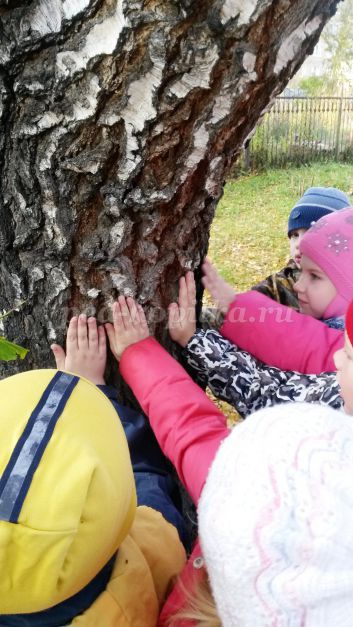


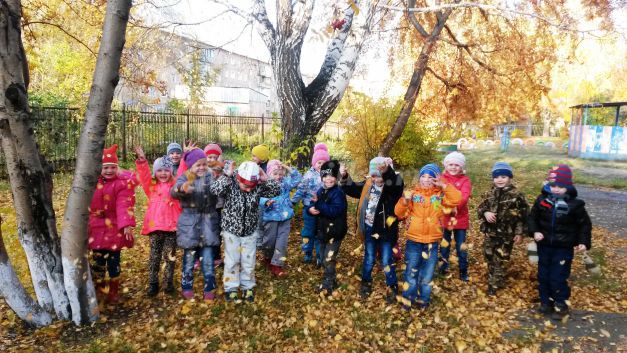
We recommend watching:
Summary of organized educational activities of children in the senior group on the topic: Autumn GCD for the senior group with a presentation on the topic: Gifts of Autumn Summary of a lesson in the senior group on the museum program on the topic: Autumn Summary of an interactive lesson using ICT in the senior group. Autumn is colorful
Similar articles:
Staged fairy tale in the senior group on the topic: Mushrooms
A dramatization of the fairy tale “Turnip” in verse for older children
Scenario of a folklore autumn holiday in the senior group
Lesson notes. Quiz on the theme “Autumn” in the senior group of kindergarten
Autumn gatherings in kindergarten. Interesting scenario. Senior group
